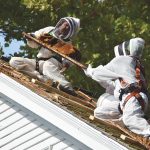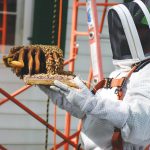Taylor House hive of activity until it’s relocated so work on roof can get underway
By Greg Ellison
(Aug. 26, 2021) Builders replacing the roof on the Calvin B. Taylor House Museum hit the pause button last Thursday so a decades-old beehive could be removed and relocated.
Taylor House Museum President Melissa Reid said the site’s cedar roof has been long overdue for attention.
“The roof on the house now was put on in the eighties,” she said.
Reid said a colony of honey bees has lived inside the museum’s roof for quite some time.
“Certainly there have been bees up in the pitch of the roof probably since the mid-’80s,” she said.
Reid said museum officials were aware of the bee inhabitants but left the workers, drones and queen well enough alone as the insects failed to cause any harm.
“You can stand on the front walk of the museum and look up and you’ll see the bees as they come out of the hive,” she said.
Reid said the hives were located after Burley Building Company began the roofing work.
“We were able to get up into the peak through the inside,” she said.

Upon closer examination the beehive was spotted tucked inside a roughly six inch by 20 foot boxed off area under the roof shingles.
Museum officials were adamant that the hive be maintained, albeit in a different locale.
“We felt very strongly that we wanted to remove these bees and relocate them to a hive that is not inside our roof,” she said.
Luckily, Burley Builders were able to enlist expert support from Whaleyville-based BayBees Honey for the undertaking.
Co-founder Lauren Pascarella, and her husband, Fred Kelly, visited the museum last Thursday to accomplish the task. Pascarella said BayBees Honey promotes backyard bee keeping and conducts educational campaigns for children.
The BayBees Honey team suited up in protective gear and to maintain calm amongst the hive inhabitants employed “smokers,” prior to lifting up and removing the entire hive.

After gently moving the hive to ground level, Pascarella took the reins and carefully sliced it into sections that were placed inside wooden frames.
In short order, Pascarella located and packed up the queen for relocation.
Pascarella said the queen was moved to a farm in Bishopville, with the rest of the hive bound to follow.
Reid said conversations are underway about a future re-introduction of bees near the museum.
For now, Reid said with all bees removed, replacing the wooden shingle roof could resume.
“The museum always has some strange thing happening,” she said. “It’s never straightforward or easy.”
